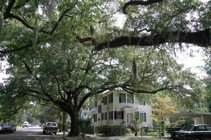i-Tree Streets Pre-Existing Inventory
Working with a pre-existing inventory

Streets's adaptive nature allows for any pre-existing complete inventory of a street tree resource to be analyzed as long as the species and diameter at breast height (DBH) are known for every tree in the inventory. Once a project has been established in Streets, users are prompted for additional information to describe and define the community, species information, and inventory parameters. The extent of these data depends on the nature of the output desired. For example, if you want to analyze costs of tree management, in addition to benefits, programmatic and other tree-related costs must be available.
Inventory data
Users can import and configure both reportable data fields analysis as well as inventory details used for managing individual tree records. These data can be a combination of actual measured values or values classified as a range. Data fields are defined within the application and are customizable to meet the protocols and definitions of most any community's existing inventory.
A (3) part instructional video series on the Streets import process can be accessed from the Video Learning page. Additional resources and guides can also be found on the Resources- Archives page under the Streets Existing Inventory Import Resources tab
Species data
Streets is preloaded with an extensive species list for each of the 16 national climate zones. However, most communities will find that after importing an inventory into Streets, several species will not be recognized. You will be prompted to define each unrecognized species with a species code, scientific and common names, and an allied match of species form and mature size (e.g., broadleaf deciduous large)
Management inputs
Though optional, city and costs data inputs allow users to utilize the full functionality of Streets's reporting features. For example, without entering street-tree program expenditures, users will not get a Benefit-Cost Ratio (BCR) report, though benefit information will still be reported. The more information (inputs) you enter, the more information Streets will return in the form of reports.
City data
These data are information about a user's community that can be used by Streets to report per capita values for benefits and costs and canopy cover reports. Typically, these inputs are easily accessible data and include parameters such as total land area, resident population, and total linear miles of street are entered.
Cost data
To provide meaningful benefit-cost ratio reporting, users are encouraged to provide up-to-date, complete and accurate cost information. Cost data include all internal and external programmatic annual costs associated with managing the street tree resource (e.g., pruning and storm clean-up costs). While Streets will run without costs inputs, the benefit-cost ratio reported will reflect only costs entered by users.
Benefit data
Benefit inputs allows the user to define the dollar value of tree-related environmental services associated with street trees. For example, the cost of a single kWh of residential electricity charged to consumers in order to establish the dollar value associated with reduced summer energy use from tree shade. Default benefit values are included for each of the 16 national climate zones and are based on prices typical for the region. Users have the option of changing these values where more city-specific data are available.